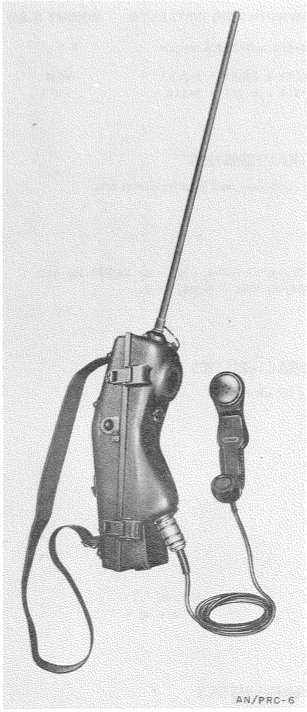AN/PRC-6
Description
Radio Set AN/PRC-6 is the FM version of the "Handie Talkie" Radio set SCR-536 and operates in a single, fixed frequency channel selected by use of an appropriate crystal. This is low-power, short-range equipment which operated in the VHF range for line of sight communications by forward elements of armored, infantry and artillery units.
This equipment consists of a light, self contained receiver-transmitter having a built-in microphone and earphone, and provision for a loop antenna which is used for homing applications. Included provision for connecting a conventional handset.
The normal antenna is a flexible tape type that is attached to the radio by a small string. The antenna is screwed into the top of the radio when in use and wrapped around the radio under the case buckets and a small clip to hold the tip when not in use.
Operated from Battery BA-270/U (which is not supplied as part of the set) and included the necessary crystal unit for the frequency in which the equipment is to operate.
Operational Characteristics
- Approximate Range
- 1 mile
- Frequency Range
- 47.0 mHz - 55.4 mHz (43 Channels)
- Modulation Type
- FM
- Type of Signal
- Voice
- Power Output
- 250 mW
Images
Sample of PRC-6 Label Reproduction
Print this label at 10% Scale and it will fit the radio perfectly
Related Files
- Radio Set AN/PRC-6, Field Maintenance
- June 1952
 Letter from BG WB Latta to BG Robert Terry (USASTRATCOM)[1]
Letter from BG WB Latta to BG Robert Terry (USASTRATCOM)[1]- Letter that dicusses the use of the PRC-6, HT-1 and RC-292 in Vietnam
- By Brigadier General W. B. Latta
- 19 August 1966
References
- ↑ Letter from BG WB Latta to BG Robert Terry (USASTRATCOM),
- "US Army Technical Manual Collection,"
- from the CECOM Historical Office archive, Aberdeen Proving Ground, MD.
- CECOM Historical Office
- "US Army Technical Manual Collection,"

